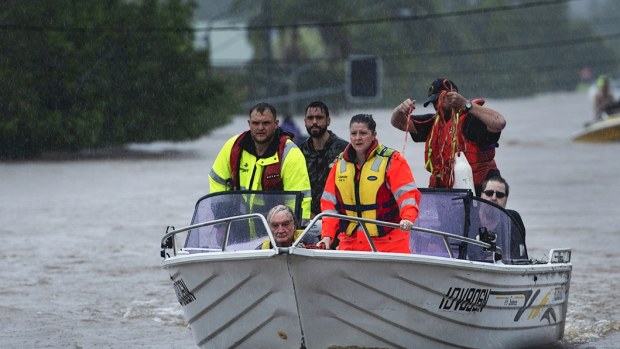How tech is helping manage a flood emergency

Juliette Murphy – like thousands of others responding to the flood crisis in south-east Queensland and northern New South Wales – has not had much sleep over the last week.
The co-founder and chief executive of Brisbane-based start-up Floodmapp has spent the past week working around the clock to provide up-to-date flood maps for Queensland’s emergency services.

Juliette Murphy, FloodMapp CEO and Ryan Prosser, co-founder and CTO in Brisbane. Peter Wallis
FloodMapp’s technology ingests vast amounts of data from rainfall, rain forecasts and river levels to model flood inundation before, during and after a severe weather event. Its models are used to support decisions about evacuations, rescues, or when the power needs to be switched off and when it is safe to be turned back on again.
“Our team had been working through the night and on early Saturday morning, we definitely realised that there were a lot of high-risk areas that were of concern,” Ms Murphy told The Australian Financial Review.
“I was setting an alarm every hour to just wake up and check if there were any other urgent support requests that were coming in.”
At the same time, Ms Murphy, who is an engineer, was keeping an eye on the situation in Northern NSW and providing “back of the envelope hydrology calculations” to her siblings who live in The Channon, a small community inland from Byron Bay.
“I said to them, ‘there’s a lot of rain coming and this is looking pretty high risk.’ They know their property is at risk, so they had a very detailed evacuation plan and evacuated ahead of time,” she said.
Their catchment received 839mm of rainfall and their house was destroyed by floodwater that reached the roof.
“You realise you can’t be there for everyone. When your company’s supporting all these emergency services for communities across the state, but then also when you know that you have family that have personally been impacted and potentially lost everything – there were a few sleepless nights for sure.”
Last month the 25-person start-up raised $6 million in a seed funding round led by Union Square Ventures’ Climate Fund, which will be used to bolster its service and expand in the US.
Patchy internet and phone coverage had hindered rescue and recovery efforts.
In Lismore, Sally Flannery and Dannielle Pickford used productivity management tool ClickUp to co-ordinate a civilian rescue effort after the town was flooded last Monday morning, trapping residents in their homes.

A civilian rescue effort in Lismore was co-ordinated through Facebook messages. Elise Derwin
The pair collated cries for help being posted on Facebook into a central database and passed that information to rescuers out on boats, including Ms Pickford’s husband, keeping track of who was safe and who still needed help.
“That first half a day was just trying to pick up who needed help, record it and get it to someone in a boat basically,” Ms Pickford said.
“You couldn’t get through to 000, you couldn’t get through to the SES. The only thing people could do was message their friends and family on Facebook.”
For the first two days monitoring the list Ms Pickford, who lives in Banora Point and has family in Lismore, had just five hours’ sleep so as not to miss any posts.
On Wednesday, her internet went out so she drove north to Kirra, in Queensland, to organise rescues for families in Coraki and Woodburn, which copped severe flooding after Lismore.
Throughout the week more than 1000 calls for help were triaged on the platform.
“There were so many people who did extraordinary things to save lives of their loved ones and the community,” Ms Pickford said.
On Monday Telstra said around 80 per cent of the 250 mobile base stations that were affected were back online and the telco had restored nearly 75 per cent of landline services, excluding nbn.
With some areas still cut off by floodwater and significant damage to some of its network, Telstra said it would take time to fully restore communication services in the flood-affected regions.
Subscribe to gift this article
Gift 5 articles to anyone you choose each month when you subscribe.
Subscribe nowAlready a subscriber?
Introducing your Newsfeed
Follow the topics, people and companies that matter to you.
Find out moreRead More
Latest In Technology
Fetching latest articles